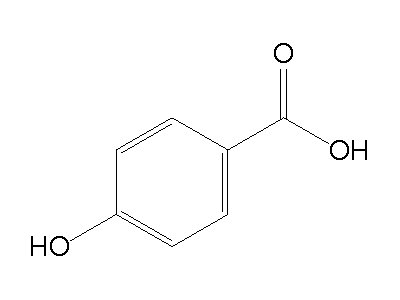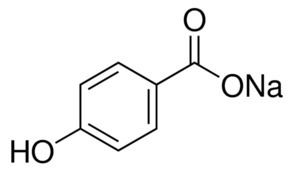Formula C7H6O3 Density 1.46 g/cm³ | Molar mass 138.12 g/mol Appearance white crystalline | |
 | ||
4-Hydroxybenzoic acid, also known as p-hydroxybenzoic acid (PHBA), is a monohydroxybenzoic acid, a phenolic derivative of benzoic acid. It is a white crystalline solid that is slightly soluble in water and chloroform but more soluble in polar organic solvents such as alcohols and acetone. 4-Hydroxybenzoic acid is primarily known as the basis for the preparation of its esters, known as parabens, which are used as preservatives in cosmetics and some ophthalmic solutions. It is isomeric with 2-hydroxybenzoic acid, known as salicylic acid, a precursor to aspirin.
Contents
- Natural occurrences
- Occurrences in food
- Related compounds
- Biosynthesis
- As an intermediate
- Biodegradation
- Glycosylation
- Chemistry
- Chemical production
- Chemical reactions
- Chemical use
- Bioactivity and safety
- References

Natural occurrences

It is found in plants of the genus Vitex such as V. agnus-castus or V. negundo, and in Hypericum perforatum (St John's wort). It is also found in Spongiochloris spongiosa, a freshwater green alga.
The compound is also found in Ganoderma lucidum, a medicinal mushroom with the longest record of use.
Cryptanaerobacter phenolicus is a bacterium species that produces benzoate from phenol via 4-hydroxybenzoate.
Occurrences in food

4-Hydroxybenzoic acid can be found naturally in Cocos nucifera. It is one of the main catechins metabolites found in humans after consumption of green tea infusions. It is also found in wine, in vanilla, in Macrotyloma uniflorum (horse gram) and in Phyllanthus acidus (Otaheite gooseberry).

Açaí oil, obtained from the fruit of the açaí palm (Euterpe oleracea), is rich in p-hydroxybenzoic acid (892 ± 52 mg/kg). It is also found in cloudy olive oil.
It is also found in the edible mushroom Russula virescens (green-cracking russula).
Related compounds
p-Hydroxybenzoic acid glucoside can be found in mycorrhizal and non-mycorrhizal roots of Norway spruces (Picea abies).

Violdelphin is an anthocyanin, a type of plant pigments, found in blue flowers and incorporating two p-hydroxy benzoic acid residues, one rutinoside and two glucosides associated with a delphinidin.
Agnuside is the ester of aucubin and p-hydroxybenzoic acid.
Biosynthesis
Chorismate lyase is an enzyme that transforms chorismate into 4-hydroxybenzoate and pyruvate. This enzyme catalyses the first step in ubiquinone biosynthesis in Escherichia coli and other Gram-negative bacteria.
Benzoate 4-monooxygenase is an enzyme that utilizes benzoate, NADPH, H+ and O2 to produce 4-hydroxybenzoate, NADP+ and H2O. This enzyme can be found in Aspergillus niger.
As an intermediate
The enzyme 4-methoxybenzoate monooxygenase (O-demethylating) transforms 4-methoxybenzoate, an electron acceptor AH2 and O2 into 4-hydroxybenzoate, formaldehyde, the reduction product A and H2O. This enzyme participates in 2,4-dichlorobenzoate degradation in Pseudomonas putida.
The enzyme 4-hydroxybenzaldehyde dehydrogenase uses 4-hydroxybenzaldehyde, NAD+ and H2O to produce 4-hydroxybenzoate, NADH and H+. This enzyme participates in toluene and xylene degradation in bacteria such as Pseudomonas mendocina. It is also found in carrots (Daucus carota).
The enzyme that 2,4'-dihydroxyacetophenone dioxygenase transforms 2,4'-dihydroxyacetophenone and O2 into 4-hydroxybenzoate and formate. This enzyme participates in bisphenol A degradation. It can be found in Alcaligenes sp.
The enzyme 4-chlorobenzoate dehalogenase uses 4-chlorobenzoate and H2O to produce 4-hydroxybenzoate and chloride. It can be found in pseudomonas sp.
The enzyme 4-hydroxybenzoyl-CoA thioesterase utilizes 4-hydroxybenzoyl-CoA and H2O to produce 4-hydroxybenzoate and CoA. This enzyme participates in 2,4-dichlorobenzoate degradation. It can be found in Pseudomonas sp.
The enzyme 4-hydroxybenzoate nonaprenyltransferase uses nonaisoprenol diphosphate and 4-hydroxybenzoate to produce diphosphate and nonaprenyl-4-hydroxybenzoate. This enzyme participates in ubiquinone biosynthesis.
The enzyme 4-hydroxybenzoate geranyltransferase utilizes geranyl diphosphate and 4-hydroxybenzoate to produce 3-geranyl-4-hydroxybenzoate and diphosphate. Biosynthetically, alkannin is produced in plants from the intermediates 4-hydroxybenzoic acid and geranyl pyrophosphate. This enzyme is involved in shikonin biosynthesis. It can be found in Lithospermum erythrorhizon.
The enzyme 3-hydroxybenzoate—CoA ligase uses ATP, 3-hydroxybenzoate and CoA to produce AMP, diphosphate and 3-hydroxybenzoyl-CoA. The enzyme works equally well with 4-hydroxybenzoate. It can be found in Thauera aromatica.
Biodegradation
The enzyme 4-hydroxybenzoate 1-hydroxylase transforms 4-hydroxybenzoate, NAD(P)H, 2 H+ and O2 into hydroquinone, NAD(P)+, H2O and CO2. This enzyme participates in 2,4-dichlorobenzoate degradation. It can be found in Candida parapsilosis.
The enzyme 4-hydroxybenzoate 3-monooxygenase transforms 4-hydroxybenzoate, NADPH, H+ and O2 into protocatechuate, NADP+ and H2O. This enzyme participates in benzoate degradation via hydroxylation and 2,4-dichlorobenzoate degradation. It can be found in Pseudomonas putida and Pseudomonas fluorescens.
The enzyme 4-hydroxybenzoate 3-monooxygenase (NAD(P)H) utilizes 4-hydroxybenzoate, NADH, NADPH, H+ and O2 to produce 3,4-dihydroxybenzoate (protocatechuic acid), NAD+, NADP+ and H2O. This enzyme participates in benzoate degradation via hydroxylation and 2,4-dichlorobenzoate degradation. It can be found in Corynebacterium cyclohexanicum and in Pseudomonas sp.
The enzyme 4-hydroxybenzoate decarboxylase uses 4-hydroxybenzoate to produce phenol and CO2. This enzyme participates in benzoate degradation via coa ligation. It can be found in Klebsiella aerogenes (Aerobacter aerogenes).
The enzyme 4-hydroxybenzoate—CoA ligase transforms ATP, 4-hydroxybenzoate and CoA to produce AMP, diphosphate and 4-hydroxybenzoyl-CoA. This enzyme participates in benzoate degradation via coa ligation. It can be found in Rhodopseudomonas palustris.
Lecythophora hoffmannii is a plant pathogen that commonly inhabits fertile soil. It is known to metabolize aromatic compounds of low molecular weight, such as p-hydroxybenzoic acid.
Glycosylation
The enzyme 4-hydroxybenzoate 4-O-beta-D-glucosyltransferase transforms UDP-glucose and 4-hydroxybenzoate into UDP and 4-(beta-D-glucosyloxy)benzoate. It can be found in the pollen of Pinus densiflora.
Chemistry
The Hammett equation describes a linear free-energy relationship relating reaction rates and equilibrium constants for many reactions involving benzoic acid derivatives with meta- and para-substituents.
Chemical production
4-Hydroxybenzoic acid is produced commercially from potassium phenoxide and carbon dioxide in the Kolbe-Schmitt reaction. It can also be produced in the laboratory by heating potassium salicylate with potassium carbonate to 240 °C, followed by treating with acid.
Chemical reactions
4-Hydroxybenzoic acid has about one tenth the acidity of benzoic acid, having an acid dissociation constant Ka = 3.3 x 10−5 M at 19 °C. Its acid dissociation follows this equation:
HOC6H4CO2H ⇌ HOC6H4CO2− + H+Chemical use
Vectran is a manufactured fiber, spun from a liquid crystal polymer. Chemically it is an aromatic polyester produced by the polycondensation of 4-hydroxybenzoic acid and 6-hydroxynaphthalene-2-carboxylic acid.
4,4'-Dihydroxybenzophenone is generally prepared by the rearrangement of p-hydroxyphenylbenzoate. Alternatively, p-hydroxybenzoic acid can be converted to p-acetoxybenzoyl chloride. This acid chloride reacts with phenol to give, after deacetylation, 4,4'-dihydroxybenzophenone.
Bioactivity and safety
4-Hydroxybenzoic acid is a popular antioxidant in part because of its low toxicity. The LD50 is 2200 mg/kg in mice (oral).
4-Hydroxybenzoic acid has estrogenic activity both in vitro and in vivo, and stimulates the growth of human breast cancer cell lines. It is a common metabolite of paraben esters, such as methylparaben. The compound is a relatively weak estrogen, but can produce uterotrophy with sufficient doses to an equivalent extent relative to estradiol, which is unusual for a weakly estrogenic compound and indicates that it may be a full agonist of the estrogen receptor with relatively low binding affinity for the receptor. It is about 500- to 100-fold less potent as an estrogen than estradiol.
